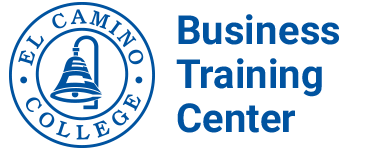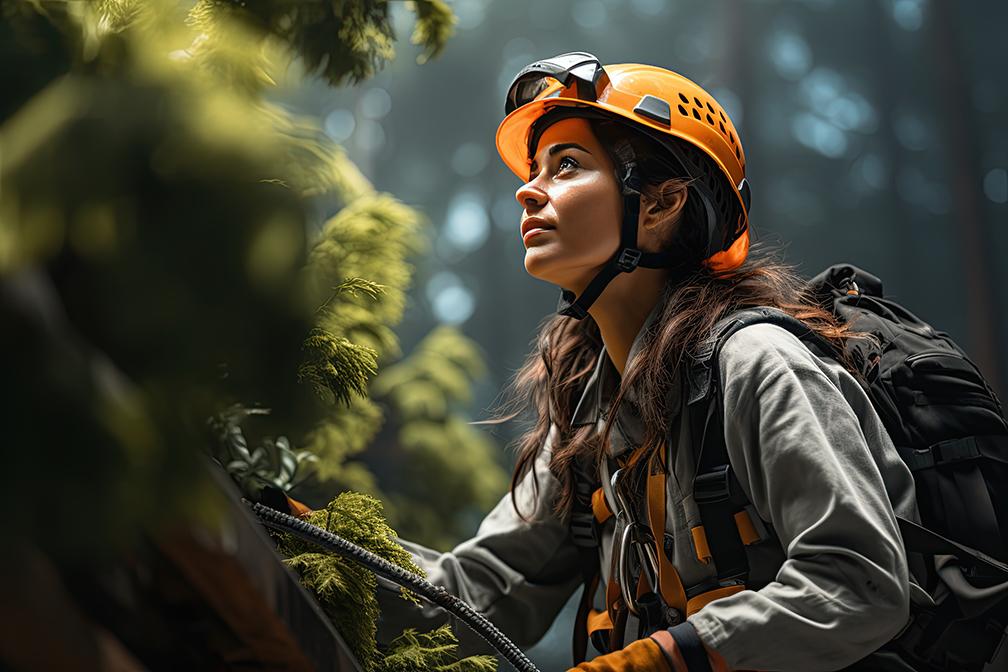Cities and municipalities across California prioritize urban forestry management to maintain the health and safety of trees on public and private lands. Tree inspectors and arborists play key roles in assessing the health of trees, identifying diseases or pests, and recommending appropriate treatments or maintenance strategies.
As climate change increases the threat of wildfires in California, especially in wildland-urban interface areas, these professionals play an important role in identifying defects in trees that could cause them to fall onto power transmission or distribution lines. In fact, utility line vegetation inspectors often work alongside fire prevention specialists and land managers to mitigate fire risks and improve vegetation management practices.
To respond to the workforce needs of utilities and municipalities, the UpSkill California Community College Collaborative, working with Butte College as project lead, has developed an intensive two-week training program that prepares individuals to begin a career as a tree line inspector. This training, coupled with field experience, is a pathway for those who are motivated to become certified arborists.
To learn more about the development of this training program, we spoke with Jim Greene, program instructor and certified arborist.
Q: What is the origin of the tree line inspection program offered by El Camino College through the UpSkill California Community College Collaborative?
Jim Greene: Kevin Eckert, founder, president and managing director of Arbor Global, initiated the program. He contacted Butte College for assistance in developing the program, and in July of 2020, he contacted me and asked if I wanted to help.
PG&E was also instrumental in helping get the program going. They provided help with funding. In fact, the first few classes were composed entirely of PG&E employees who were all certified arborists. They gave us a lot of feedback and insight about what was good and what we should pare down. They have been a great partner.
The training program that Kevin originally put together was more intensive than our current iteration. We’ve streamlined it over time and have gotten to where we like it and where it works for students.
Q: For which college districts have you provided the training?
Greene: We have held the training at Colleges including Butte College, College of the Sequoias, El Camino College, San Bernardino Community College District and San Diego Community College.
Q: How long is the training?
Greene: The training is taught over two weeks. Students are in class 40 hours per week.
Q: How is the training structured? What topics are taught?
 Greene: The first week is pretty much all classroom work, and then we take short trips out into the field where we go out and observe what we’ve talked about in class. On the first day, we give students an introduction to the Electrical Hazard Awareness Program, where we teach them about identification of the utility facilities, which means the power lines, the equipment, the poles. These are the things they will be inspecting. We teach them how to distinguish what they’re supposed to be looking at. For example, they will be observing what we call “grow-ins,” which refers to the rate of growth of trees and how close the trees are to the power lines. They will also be looking for “fall-ins,” which refers to defects in trees that could cause them to fall onto transmission or distribution lines. Grow-ins and fall-ins have a time frame associated with them by the utilities, which in California is typically 12 to 18 months.
Greene: The first week is pretty much all classroom work, and then we take short trips out into the field where we go out and observe what we’ve talked about in class. On the first day, we give students an introduction to the Electrical Hazard Awareness Program, where we teach them about identification of the utility facilities, which means the power lines, the equipment, the poles. These are the things they will be inspecting. We teach them how to distinguish what they’re supposed to be looking at. For example, they will be observing what we call “grow-ins,” which refers to the rate of growth of trees and how close the trees are to the power lines. They will also be looking for “fall-ins,” which refers to defects in trees that could cause them to fall onto transmission or distribution lines. Grow-ins and fall-ins have a time frame associated with them by the utilities, which in California is typically 12 to 18 months.
On the second day, we give students an introduction to tree identification and tree biology. Students need to learn the characteristics of various species, which takes a long time.
On the third day, we spend the entire time talking about tree defects. We discuss the defects that can affect a tree’s roots, trunk, branches. And we also talk about soil; how can all these elements affect the strength and biomechanics of a tree, and what could cause a tree to fail.
On day four, we talk about tree risk assessment. During these discussions we’re bringing together all the different aspects under study — the biology, anatomy, physiology and defects of a tree — that when analyzed together enables us to make a Level One assessment, which determines if a tree defect is going to cause trouble for our power lines. A Level One assessment can be performed by an assessor as a walk-by, a drive-by or a fly-by, using drones or helicopters.
The emphasis in this class is to be able to assess large numbers of tree populations in a time frame that a utility requires, and to do it reliably so that the utility can make management decisions on their vegetation management programs.
We also spend time on customer service and interactions because many times the trees we are inspecting are on people’s private property.
Q: Are there times during an inspection that additional resources are brought in?
Greene: Yes. If the person performing the initial inspections encounters something they’re not familiar with or something that causes them concern, they are instructed to call for a Level Two inspection, which is performed by a certified arborist.
Q: Once a student completes the 80-hour training class, what does it take to become a certified arborist?
Greene: There are several pathways to become a certified arborist. One path is for an assessor to have three years of field experience, which would qualify them to take the certified arborist exam. If someone has a four-year degree in a natural science curriculum such as forestry, biology or geology, then they would only need one year of field experience. Or if someone has an associate degree and worked in a nursery for two years, that will suffice for them to take the exam. All applications to take the exam must be approved by the International Society of Arboriculture (ISA). So, there’s several opportunities.
Overview of the arborist profession
- Arborists work for municipalities, power companies, arborist firms and large companies that do contract work for municipal governments and power companies. After gaining experience, some start their own tree care businesses or become a consultant.According to the U.S. Bureau of Labor Statistics (BLS), arborists, who fall under the broader BLS category of conservation scientists and foresters, earned a median salary of $64,020 as of May 2020.
The job demand for arborists is projected to increase by 7% between 2020 and 2030. Our future “smart cities” are slated to include more green space, and many cities and towns are already planting more trees. This trend will open up opportunities for arborists, particularly in warmer areas that need landscaping year-round.
Source: environmentalscience.org
For more information about the tree line inspector training program offered by El Camino College, please contact:
Eldon R. Davidson
Director, Center for Customized Training
El Camino College – Business Training Center
13430 Hawthorne Blvd.
Hawthorne, CA 90250
Email: edavidson@elcamino.edu

